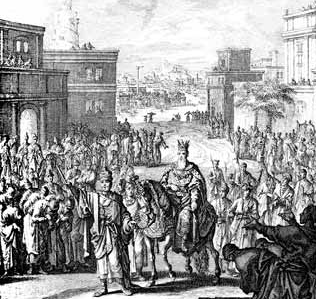
On the 13th of Adar in 3405, a disaster loomed over the Jewish community in Persia. Thanks to the bravery of Mordecai and Esther, the threat was avoided and the tragedy turned to celebration, marking a significant Jewish festival of survival and Divine providence.
The Plot in Persia
According to Jewish religious texts, on the 13th of Adar in the Hebrew year 3405, something dark was brewing for the Jewish community in the great land of Persia. But thanks to the solidarity between the Jews, particularly the wise policies of an elderly cleric named Mordecai and the sacrifices of his cousin Esther, this imminent disaster was miraculously avoided. This entire event is detailed in one of the Jewish holy books, the Scroll of Esther.
A Royal Feast and a Queen’s Defiance
In 3396, corresponding to 367 BC, Xerxes I (Ahasuerus), son of Darius of the Achaemenid dynasty, organized a magnificent seven-day banquet to demonstrate his power. He decreed that gifts be given to all inhabitants of Susa and that everyone could eat and drink as they pleased, with all invitees granted access to the inner gardens of the palace, where they could meet the king.
During this event, the inebriated king demanded that his wife, Queen Vashti, appear before the guests. She refused, which led to her immediate removal from her position and her execution by the executioner. The king soon regretted this rash decision and promptly sought a replacement for the Queen of Persia.
Esther’s Ascension
The Jewish Queen
Out of thousands of eligible candidates from 127 provinces of Persia, a Jewish girl named Esther was selected to marry Xerxes I and thus became the Queen of Persia. Like a caring father, Mordecai constantly advised and supported Esther, encouraging her not to fear her circumstances and to embrace her destiny, as there was surely a Divine wisdom in it.
The root of the plot
A deep clash with one of the polytheistic ministers of the king became the root of an evil plot. Even though Mordecai worked in the royal court as the religious leader of the Jewish community, a minister called Haman expected him to prostrate before the idol that hung around his neck. Mordecai refused. Haman took this as an insult and rebellion, representative of Jewish thought.
Haman’s Conspiracy
Haman used all his influence to convince Xerxes that the Jews were rebellious citizens. With constant absences, he convinced the king that the Jews refused to comply with royal laws and avoided paying taxes. Ultimately, he succeeded in obtaining the royal seal by offering a large amount of ten thousand talents of silver to the king’s treasury as blood money — all to destroy a nation that refused to bow down before the idol Baal. He drew lots, but mistakenly chose the 13th day of Adar for the execution of this decree, confusing it with the 7th of Adar, which is the anniversary of Moses’s birth and death. He summoned the scribes to draft the decree, which was then given to the fastest riders and skilled messengers to announce across all provinces.
Esther’s Intervention
The decree was clear: it was confidential, it was completely serious, and it was to be executed and completed on the same day, the 13th Adar. The Jews were to be executed and eliminated from the entire country in one day.
Having learned of this evil plot, Mordecai informed Queen Esther of this imminent threat and urged her to use her royal position to prevent the catastrophe. Mordecai reminded her, ‘Now is the time for you to fulfill your duty to your community, for God has chosen you and elevated you to a high position for such a day as this.’
Following Esther and Mordecai’s advice, the Jews fasted for three days and prayed for Divine mercy. At the same time, Esther arranged an audience with the king to reveal the reality of Haman’s plot and to request help for her community. During her conversation, she reminded the king of Mordecai’s services in uncovering a plot to assassinate him. Esther succeeded in directing the king’s attention to the truth and repelling the danger from the Jews.
The Legacy of Purim
Tragedy averted
Jews worldwide have celebrated Purim for centuries, marking its significance in various contexts. This historical event is particularly important because it represented a near catastrophe for Diaspora Jews, the first of its magnitude since the destruction of the Second Temple.
Authenticity of Iranian Jews
On another note, it may signify that Iranian Jews, with their long history spanning over 2,700 years, are among the most authentic Jewish communities in the world.
Cultural and religious significance
Furthermore, Purim not only holds a special place as a religious celebration but, like other Jewish festivals, also represents a unique cultural and religious foundation.
Sample of Divine providence
By delving into and analyzing the Megillah of Esther alongside the Torah, one can uncover valuable and profound insights. For instance, this text highlights Divine providence and how it manifests through seemingly random and ordinary events, influenced by the actions and intentions of everyday people. While these Divine plans may initially seem incomprehensible and strange, over time and with a broader view of history, a much more beautiful picture of this Divine wisdom and guidance emerges.

Festival Traditions
In Old-Persian dictionaries, the word “Purim” comes from the root “Pur”, meaning “lot”. Every year on the 13th of Adar, Jews observe a day of fasting to remember the three days of fasting. On the night of the 13th and the day of the 14th of Adar, the Megillah of Esther is read from a special scroll, and the Purim festival, or the Festival of Lots, is celebrated. During the reading of the Megillah, whenever Haman’s name is mentioned, children blow whistles and rattles, and adults stomp their feet. Sending gifts of food or drink to friends and acquaintances and helping the needy are considered religious duties during this festival.
During the Purim festival, young people wear special costumes, put on various masks, participate in carnivals, and engage in dancing and celebrations.
Further Notes on Purimfor Jews:
- All healthy adults, both men and women, are required to observe this fast.
- If the 13th of Adar falls on Shabbat, the Fast of Esther is moved to the preceding Thursday, which is the 11th of Adar.
- During Shacharit (Morning Prayer) and Mincha (Afternoon Prayer) on the fast day, the Aneinu section (עננו) is recited, and a portion of the Torah is read during both services.
- Before Purim, each person must give a specified amount of money to charity officials, the amount of which is announced each year and represents half a shekel.
- Reading the Megillah and reciting the blessings over it is only possible with a kosher Megillah (written according to the laws on kosher parchment). For those who do not have access to this type of Megillah or cannot read it, the Shaliach Tzibbur (prayer leader) performs this mitzvah on behalf of the congregation. Both the Shaliach Tzibbur and the congregation need to have the proper intention for this act.
- At night, before reading the Megillah, three blessings (including Shehecheyanu) are recited, and one blessing is said after its completion. In the morning, the Shehecheyanu blessing (שהחיינו) is not recited. The Shaliach Tzibbur, who is the Megillah reader, must intend to represent the congregation before saying the blessing and should ask them to have the intention of fulfilling the mitzvah by hearing the blessing from him. Therefore, the congregation should not say “Baruch Hu Uvaruch Shemo (ברוך הוא וברוך שמו)” when hearing the blessings but should only respond with “Amen”.
- A significant duty on Purim is giving gifts to the poor. Another mitzvah of this celebration is sending food gifts to friends.
Today, the tomb of Esther and Mordechai in the center of Hamadan is part of Iran’s cultural heritage and is considered one of the important pilgrimage sites


 فارسی
فارسی